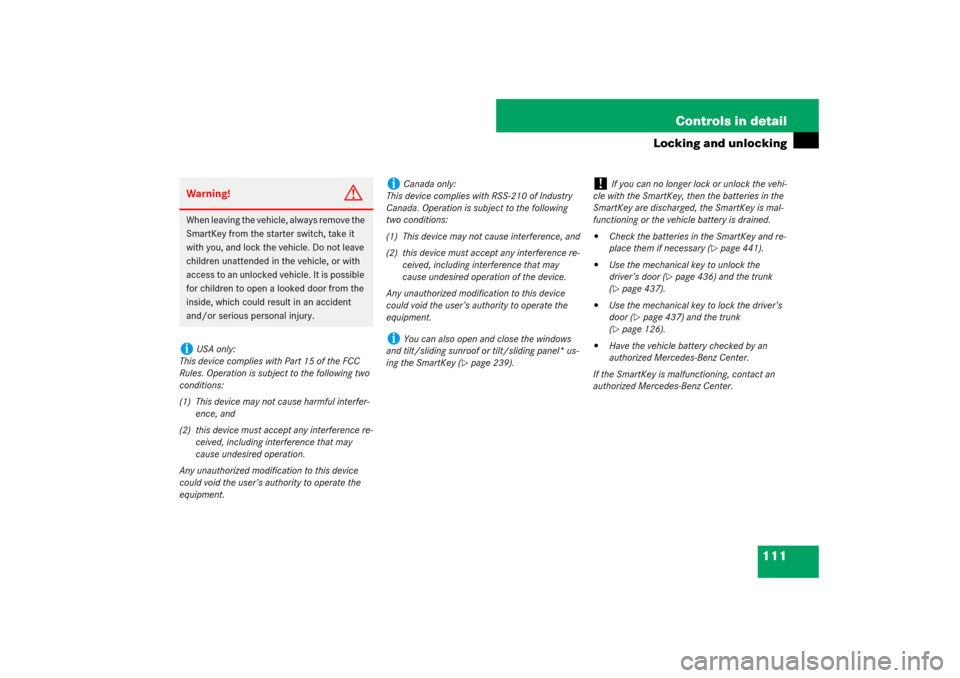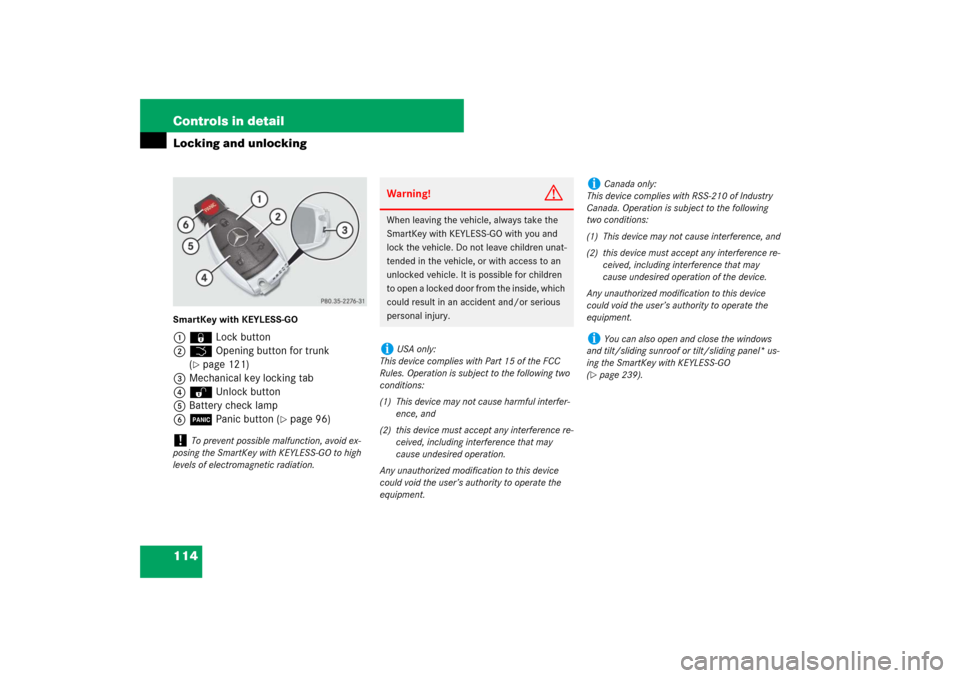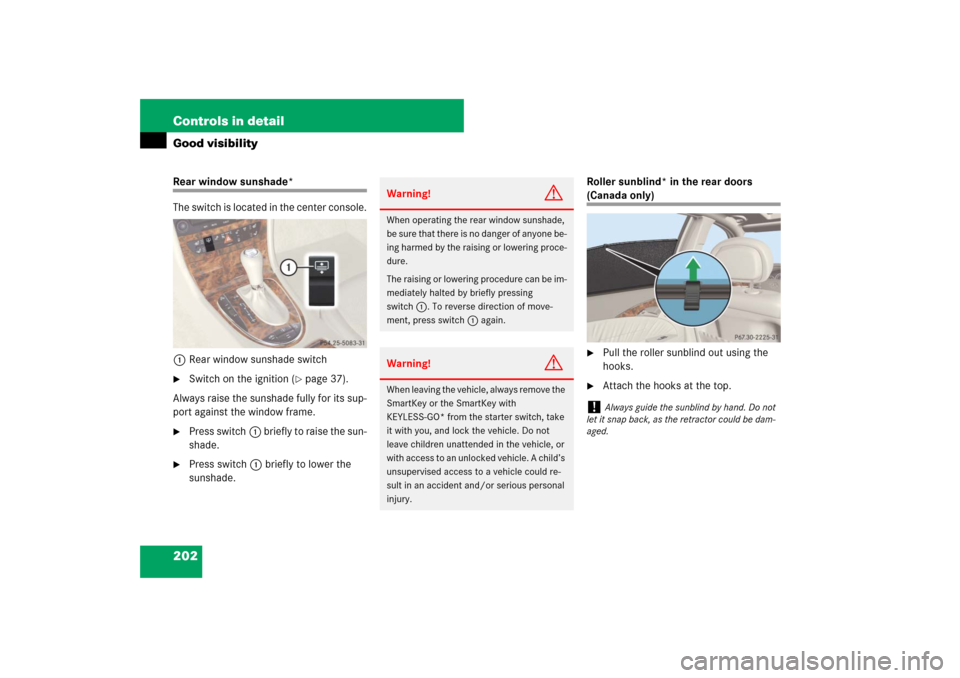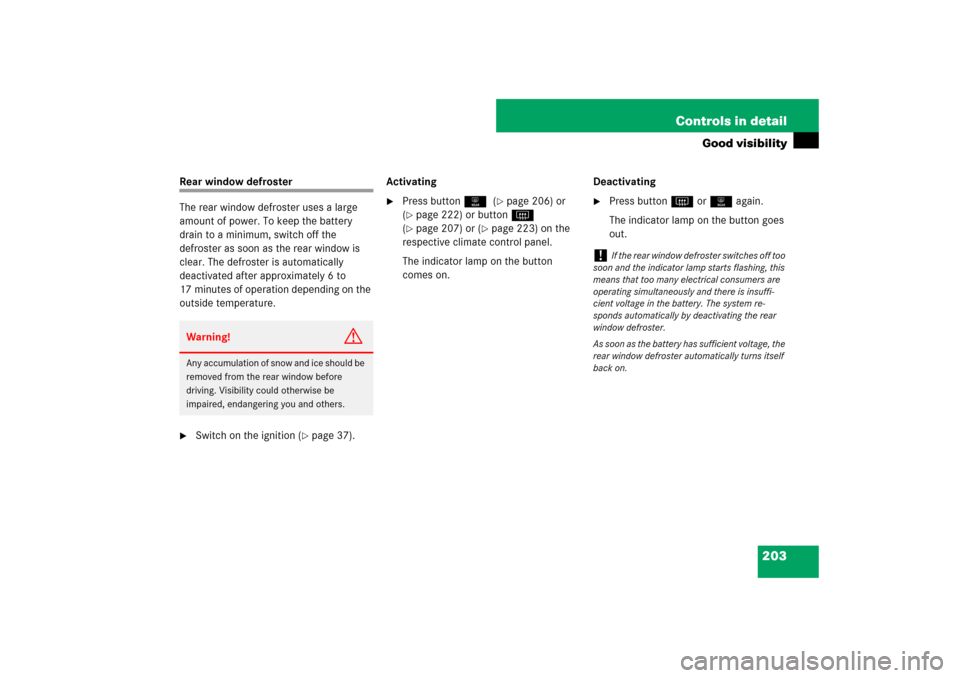Page 112 of 522

111 Controls in detail
Locking and unlocking
Warning!
G
When leaving the vehicle, always remove the
SmartKey from the starter switch, take it
with you, and lock the vehicle. Do not leave
children unattended in the vehicle, or with
access to an unlocked vehicle. It is possible
for children to open a looked door from the
inside, which could result in an accident
and/or serious personal injury.i
USA only:
This device complies with Part 15 of the FCC
Rules. Operation is subject to the following two
conditions:
(1) This device may not cause harmful interfer-
ence, and
(2) this device must accept any interference re-
ceived, including interference that may
cause undesired operation.
Any unauthorized modification to this device
could void the user’s authority to operate the
equipment.
i
Canada only:
This device complies with RSS-210 of Industry
Canada. Operation is subject to the following
two conditions:
(1) This device may not cause interference, and
(2) this device must accept any interference re-
ceived, including interference that may
cause undesired operation of the device.
Any unauthorized modification to this device
could void the user’s authority to operate the
equipment.
i
You can also open and close the windows
and tilt/sliding sunroof or tilt/sliding panel* us-
ing the SmartKey (
�page 239).
!
If you can no longer lock or unlock the vehi-
cle with the SmartKey, then the batteries in the
SmartKey are discharged, the SmartKey is mal-
functioning or the vehicle battery is drained.
�
Check the batteries in the SmartKey and re-
place them if necessary (
�page 441).
�
Use the mechanical key to unlock the
driver’s door (
�page 436) and the trunk
(
�page 437).
�
Use the mechanical key to lock the driver’s
door (
�page 437) and the trunk
(
�page 126).
�
Have the vehicle battery checked by an
authorized Mercedes-Benz Center.
If the SmartKey is malfunctioning, contact an
authorized Mercedes-Benz Center.
Page 115 of 522

114 Controls in detailLocking and unlockingSmartKey with KEYLESS-GO 1‹ Lock button
2Š Opening button for trunk
(
�page 121)
3Mechanical key locking tab
4ΠUnlock button
5Battery check lamp
6Â Panic button (
�page 96)
!
To prevent possible malfunction, avoid ex-
posing the SmartKey with KEYLESS-GO to high
levels of electromagnetic radiation.
Warning!
G
When leaving the vehicle, always take the
SmartKey with KEYLESS-GO with you and
lock the vehicle. Do not leave children unat-
tended in the vehicle, or with access to an
unlocked vehicle. It is possible for children
to open a locked door from the inside, which
could result in an accident and/or serious
personal injury.i
USA only:
This device complies with Part 15 of the FCC
Rules. Operation is subject to the following two
conditions:
(1) This device may not cause harmful interfer-
ence, and
(2) this device must accept any interference re-
ceived, including interference that may
cause undesired operation.
Any unauthorized modification to this device
could void the user’s authority to operate the
equipment.
i
Canada only:
This device complies with RSS-210 of Industry
Canada. Operation is subject to the following
two conditions:
(1) This device may not cause interference, and
(2) this device must accept any interference re-
ceived, including interference that may
cause undesired operation of the device.
Any unauthorized modification to this device
could void the user’s authority to operate the
equipment.
i
You can also open and close the windows
and tilt/sliding sunroof or tilt/sliding panel* us-
ing the SmartKey with KEYLESS-GO
(
�page 239).
Page 200 of 522

199 Controls in detail
Good visibility
Warning!
G
The auto-dimming function does not react if
incoming light is not aimed directly at the
sensors in the interior rear view mirror.
The interior rear view mirror and the exterior
rear view mirror on the driver’s side do not
react, for example, if the rear window sun-
shade* is in raised position.
Light hitting the mirror(s) at certain angles
(incident light) could blind you. As a result,
you may not be able to observe traffic con-
ditions and could cause an accident.
Warning!
G
In case of an accident, liquid electrolyte may
escape from the mirror housing if the mirror
glass breaks.
Electrolyte has an irritating effect. Do not al-
low the liquid to come into contact with
eyes, skin, clothing, or respiratory system.
In case it does, immediately flush affected
area with water, and seek medical help if
necessary.!
Electrolyte drops coming into contact with
the vehicle paint finish can be completely re-
moved only while in the liquid state by applying
plenty of water.
Warning!
G
Exercise care when using the
passenger-side exterior rear view mirror.
The mirror surface is convex (outwardly
curved surface for a wider field of view). Ob-
jects in mirror are closer than they appear.
Check your interior rear view mirror or
glance over your shoulder before changing
lanes.
Page 202 of 522
201 Controls in detail
Good visibility
Sun visors
The sun visors protect you from sun glare
while driving.�
Swing sun visor1 down when you ex-
perience glare.1Sun visor
2Vanity mirror
3Mirror cover
4Mirror lamp
�
To use the vanity mirror2, lift up the
mirror cover3.5Sun visor
6Additional visor*
7Mounting
If sunlight enters through a side window:
�
Disengage sun visor5 from
mounting7.
�
Pivot sun visor5 to the side.
�
Adjust the sun visor5 by pushing or
pulling in direction of arrows.
Warning!
G
Do not use the vanity mirror while driving.
Keep the mirrors in the sun visors closed
while vehicle is in motion. Reflected glare
can endanger you and others.
i
If sun visor1 is disengaged from
mounting7 with mirror cover3 open, mirror
lamp4 will switch off.
i
Close mirror cover3 (if open) before you
disengage the sun visor5 from mounting7
and pivot it to the side.
Page 203 of 522

202 Controls in detailGood visibilityRear window sunshade*
The switch is located in the center console.
1Rear window sunshade switch�
Switch on the ignition (
�page 37).
Always raise the sunshade fully for its sup-
port against the window frame.
�
Press switch1 briefly to raise the sun-
shade.
�
Press switch1 briefly to lower the
sunshade.Roller sunblind* in the rear doors
(Canada only)�
Pull the roller sunblind out using the
hooks.
�
Attach the hooks at the top.
Warning!
G
When operating the rear window sunshade,
be sure that there is no danger of anyone be-
ing harmed by the raising or lowering proce-
dure.
The raising or lowering procedure can be im-
mediately halted by briefly pressing
switch1. To reverse direction of move-
ment, press switch1 again.Warning!
G
When leaving the vehicle, always remove the
SmartKey or the SmartKey with
KEYLESS-GO* from the starter switch, take
it with you, and lock the vehicle. Do not
leave children unattended in the vehicle, or
with access to an unlocked vehicle. A child’s
unsupervised access to a vehicle could re-
sult in an accident and/or serious personal
injury.
!
Always guide the sunblind by hand. Do not
let it snap back, as the retractor could be dam-
aged.
Page 204 of 522

203 Controls in detail
Good visibility
Rear window defroster
The rear window defroster uses a large
amount of power. To keep the battery
drain to a minimum, switch off the
defroster as soon as the rear window is
clear. The defroster is automatically
deactivated after approximately 6 to
17 minutes of operation depending on the
outside temperature.�
Switch on the ignition (
�page 37).Activating
�
Press button1 (
�page 206) or
(
�page 222) or buttonF
(�page 207) or (
�page 223) on the
respective climate control panel.
The indicator lamp on the button
comes on.Deactivating
�
Press buttonF or1 again.
The indicator lamp on the button goes
out.
Warning!
G
Any accumulation of snow and ice should be
removed from the rear window before
driving. Visibility could otherwise be
impaired, endangering you and others.
!
If the rear window defroster switches off too
soon and the indicator lamp starts flashing, this
means that too many electrical consumers are
operating simultaneously and there is insuffi-
cient voltage in the battery. The system re-
sponds automatically by deactivating the rear
window defroster.
As soon as the battery has sufficient voltage, the
rear window defroster automatically turns itself
back on.
Page 207 of 522
206 Controls in detailDual-zone automatic climate controlUSA only1
Temperature control, driver’s side
2
Front defroster
3
Increasing air volume
4
Display
5
Air distribution
6
Rear window defroster
7
Temperature control, passenger side
8
MAX COOL on/off
9
AC cooling on/off
a
Climate control on/off
b
Decreasing air volume
c
Air recirculation
d
Air distribution and air volume
(automatic, manual)
Page 208 of 522
207 Controls in detail
Dual-zone automatic climate control
Canada only1
Temperature control, driver’s side
2
Front defroster
3
Increasing air volume
4
Display
5
Air distribution
6
Rear window defroster
7
Temperature control, passenger side
8
Residual heat/ventilation
9
AC cooling on/off
a
Climate control on/off
b
Decreasing air volume
c
Air recirculation
d
Air distribution and air volume
(automatic, manual)